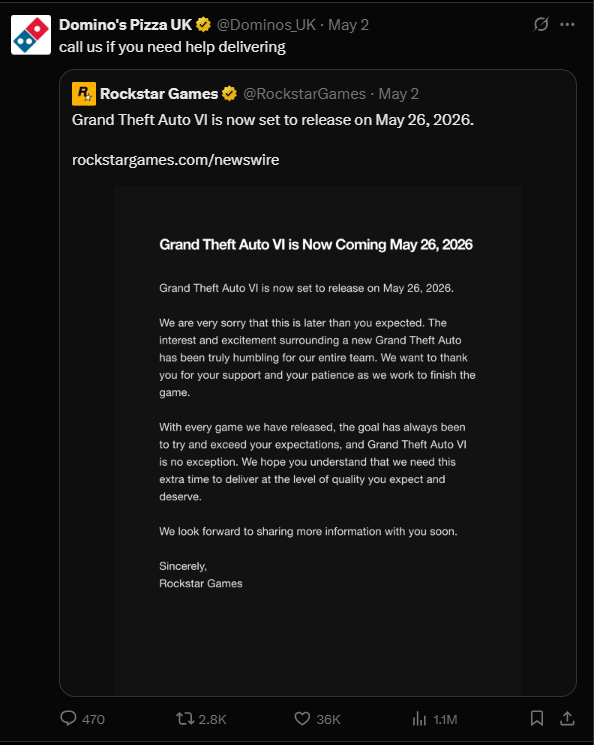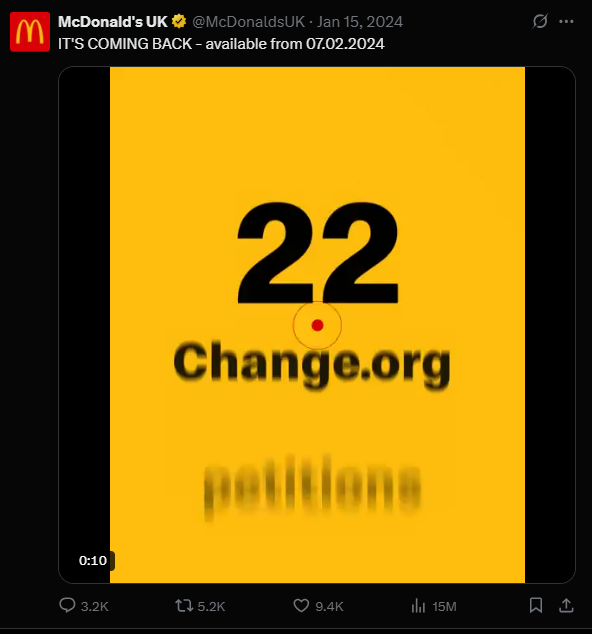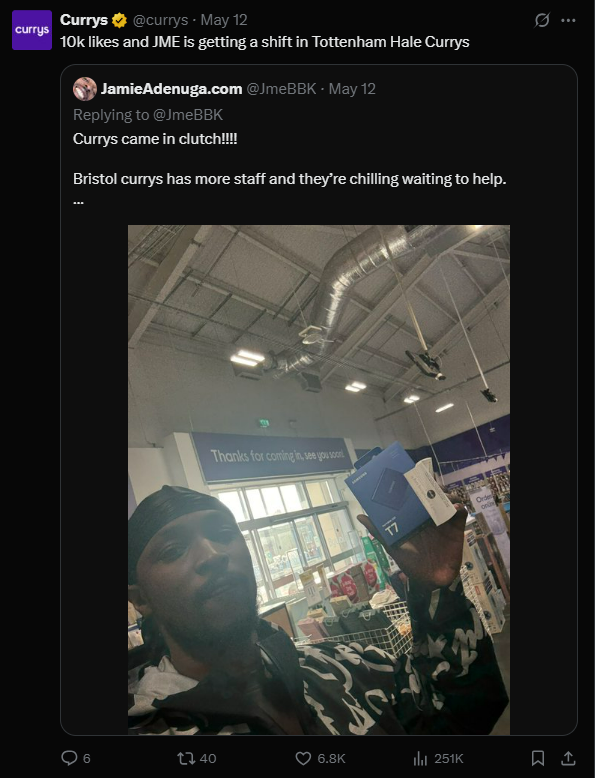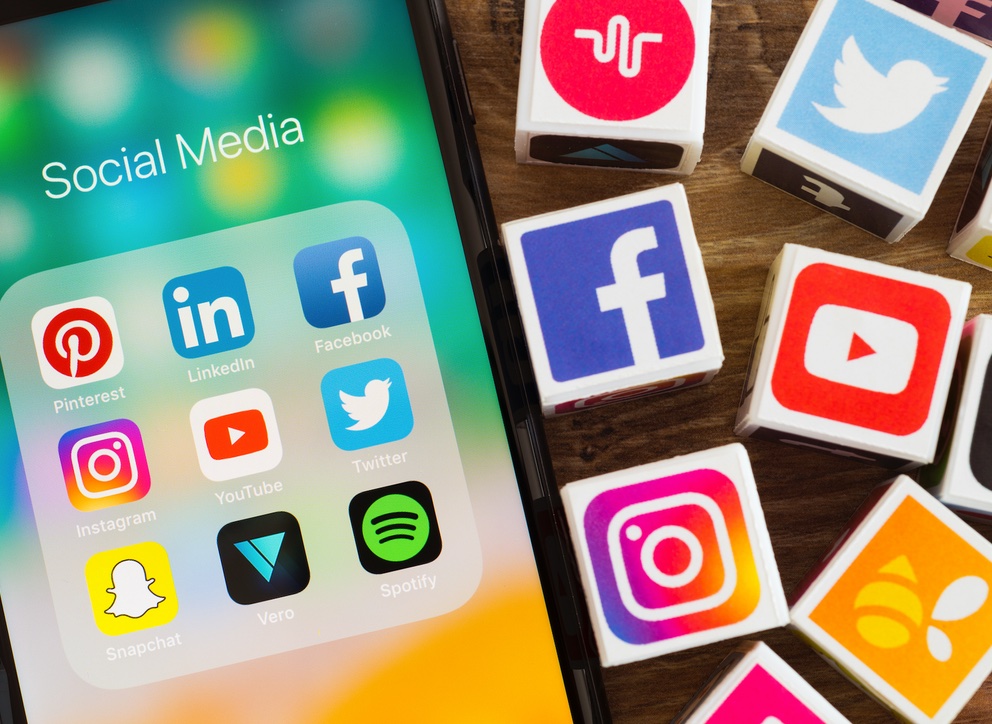Introduction
Social media has become essential to every brand’s marketing efforts. A strong social presence can help brands connect with their audience, build relationships and drive sales. This makes an effective social media engagement strategy the heart of all successful digital campaigns.
Brands use various methods to boost their engagement on social media — from advertising and educational material to reactive and interactive content. The type of content a business chooses to post can make a significant difference to the engagement rate, especially in a saturated digital space where humour is emerging as a powerful tool.
This article explores how humorous vs. serious social media content performs, with a particular focus on Twitter/X. The research includes both B2B and B2C examples to uncover trends in what really drives higher engagement and connection across sectors.
B2C Brands: Driving Comments, Shares, and Laughs
Let’s begin with B2C brands — where tone and timing often make or break a campaign. For brands targeting everyday consumers, striking the right balance in tone of voice is essential. A single social media post can either spark a wave of commenting and sharing or disappear unnoticed. In this section, we’ll explore how B2C companies approach their social media content, comparing humorous vs. serious styles. We’ll look at the genres they tap into, how their posts are received, and what this tells us about creating an effective social media engagement strategy.
Fast Food: Domino’s vs McDonald’s
Domino’s is a brilliant example of how humour can power a successful social media marketing campaign. Their X strategy doesn’t rely on pushing their products directly. Instead, they use trending topics, memes, and jokes to create social media posts that spark discussion.
One of their standout moments involved quote-tweeting football journalist Fabrizio Romano with the phrase “EL Clownico” to mock Manchester United and Tottenham Hotspur.
The post received 181,000 likes and showcased how tapping into viral sports moments can increase visibility. Another example was a tweet to Rockstar Games about GTA6 delays, cleverly referencing their own delivery service: “Call us if you need help delivering.” That post hit 36,000 likes and over a million views.

These humorous in-the-moment posts often encourage people to comment and share, becoming active participants in the conversation. Though unrelated to pizza, the brand still stays top-of-mind — particularly when Domino’s uses its banner image to promote new menu items.
If
Even if only 1% of the audience clicks on their profile, that will translate to thousands of eyes on the product. This is a low-cost, high-reward engagement strategy that drives visibility and conversions.
McDonald’s takes a very different approach. While Domino’s tweets up to five times a day and engages regularly with trending topics, McDonald’s UK has barely posted at all this year. Despite being a much bigger brand globally, McDonald’s has fewer Twitter followers than Domino’s — 258,000 compared to 309,000 — which highlights the value of consistent, engaging social media content. Most of McDonald’s posts focus solely on products, and while their posts about the breakfast wrap gained around 20 million views in total, this level of reach is rare and mostly driven by product popularity. Regular posts tend to achieve decent view counts but fall short in terms of overall engagement and memorability.
Much of the interaction McDonald’s receives comes from users asking for discontinued items to return, like the Chicken Legend. This could be a deliberate tactic to create hype and increase social media engagement when items are brought back, but it leans heavily on nostalgia rather than a proactive strategy.
It could be argued that McDonald’s is redirecting its focus to other social media platforms in response to X’s significant decline in user numbers. Between August 2024 and April 2025, the platform lost over 20 million users, dropping from more than 110 million to around 95 million (SocialMediaToday). However, even when user numbers were higher (the below screenshot is from 2024), McDonald’s strategy on X was underperforming. In contrast, Domino’s continues to see strong engagement by leaning into a humour-driven approach, gaining higher numbers even in 2025 after the decline in X users. Their content strategy remains effective, highlighting that platform size alone doesn’t determine success—creative execution still matters.

If McDonald’s adopted a more dynamic, playful approach like Domino’s—tapping into broader genres such as football, gaming, or current events—it would likely see a stronger performance across its social media platforms. At present, its lack of regular, relatable content means it’s missing out on both meaningful engagement and potential sales. In a fast-moving social media marketing environment, staying active and culturally relevant is essential to maintaining a strong social media presence.
Gambling Companies: Paddy Power vs Bet365
This industry offers one of the clearest contrasts in tone and social media engagement strategy.
Paddy Power thrives on humour, sarcasm and pop culture references — particularly when targeting football fans. Their campaign “Battle of the Bottle Jobs” mocked both Spurs and Manchester United’s poor performances despite reaching European finals. This type of humour resonates with fans and creates social media content that users can laugh at, relate to, and share.
Other stunts include taking a fake trophy to Arsenal’s Emirates Stadium that read “best team in the Champions League” after the team’s knockout. Their X posts, which often include memes, swearing, or satire, become widely circulated, helping users associate Paddy Power with personality and approachability. Their blogs and videos further reinforce a brand identity rooted in levity, relatability, and confidence — all of which contribute to higher engagement and build trust among their audience.
Bet365, by comparison, maintains a professional and product-heavy tone. Their posts mainly focus on betting odds, with little variation in style. Despite having nearly 500,000 followers, Bet365’s posts rarely break double-digit likes — a sign that their social media engagement strategy is not connecting. Without humour, relatable tone, or interactive content, users don’t feel inclined to participate, and the brand misses out on potential growth through shares and reactions.
Tech Retail: Currys vs Argos
In the tech retail space, Currys has leaned into light-hearted humour with good results. Their X bio — “not selling curry” — immediately sets a playful tone. A great example is when they replied to rapper JME’s tweet praising their staff with a joke about giving him a shift at their Tottenham Hale store. The tweet went viral, and while JME obviously wasn’t taking up the job, the playful exchange was great publicity.

Currys also gets involved in football banter, like “banning” Trent Alexander-Arnold from their Liverpool store after he left Liverpool FC for Real Madrid. This timely humour, paired with user generated content, keeps them part of conversations where their audience is already active.
When they do post product ads, they often perform worse — usually under 100 likes — highlighting that humour leads to far more engagement on social media.
On the other hand, Argos hasn’t tweeted since November 2024 and rarely posts content that invites commenting and sharing. Most of their social media posts are either product promotions or service updates, the latter often attracting negative feedback. Rather than sparking conversations or laughter, they’re simply broadcasting — which does little to boost engagement rate. A dedicated support account might handle complaints better, allowing the main profile to focus on engaging, brand-building content.
B2B Brands: Reserved But Ripe for Opportunity
Unlike B2C brands, B2B companies have largely avoided humour in their social media engagement strategies. It’s true — B2B audiences are different, and the perceived risk of appearing unprofessional can feel higher. But at the end of the day, you’re still marketing to people. The real challenge isn’t the audience — it’s often a bravery problem. Too many B2B brands shy away from bold, creative campaigns because they’re worried about pushing boundaries, even when those boundaries are exactly what’s needed to stand out. Despite this there are some signs that humour could still be effective.
HubSpot incorporates trending memes and jokes like the “ice bowl” meme captioned “sales reps with a week to go in Q1.” Another playful post read “normalise having a CRM that doesn’t give you trust issues.” These types of social media content demonstrate awareness of platform culture, and while they don’t always achieve massive reach, they represent an effort to connect more authentically.
Shopify and Supabase also blend humour with business-focused updates. They post viral memes, gifs, and casual language while still promoting their services. However, unlike B2C brands, they stay firmly within their professional domain — rarely experimenting with broad pop culture content. That conservatism may be holding them back. A clever, well-timed humorous post could lead to user generated content, better engagement rates, and a more recognisable brand.
There’s clearly a gap in the B2B space: brands with the confidence and creative agility to balance professionalism with relatability could stand out significantly.
Conclusion: Humour as a Core Social Media Engagement Strategy
Across both B2C and B2B, the evidence points to a clear trend: humour leads to higher engagement and share of spend. It gets people talking, boosts visibility, and makes a brand more memorable. This doesn’t mean that every post on social media needs to be a joke — but incorporating humour, lightness and play into your social media engagement strategy is an invaluable tool.
Companies like Paddy Power, Domino’s, and Currys show how humour — when aligned with the brand voice — can lead to better comments, shares, and long-term brand awareness. They also demonstrate that it’s possible to balance laughs with high quality promotions that still push products.
In contrast, more traditional or serious brands, especially in B2B, risk blending into the background. For them, embracing a smarter, funnier, and more culturally aware approach could mean unlocking a new level of engagement and growth.
Ultimately, humour isn’t just entertaining — it’s strategic. If you’re aiming to increase social media engagement, don’t overlook the power of a well-timed joke.










